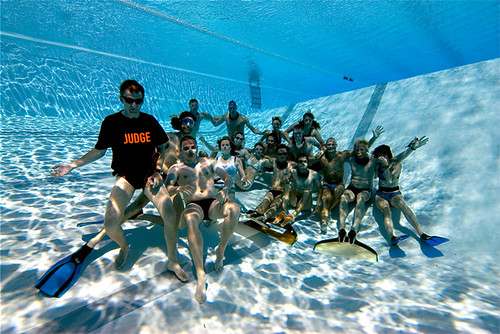Much has been said about the effects of the lanyard and the CBS but I know of no real field test, not until now. After a long competition day, Sebastian Näslund, organizer of the Nordic Deep, decides to change that. He asks me to fix a lanyard around his waist and the bottom plate to be dropped to 50m. He instructs the boat crew of when to release the CBS and then he goes down. Stig Severinsen and me are first and secondary safety divers.
As the CBS is released I have time to watch the weights go down and the rope being pulled up quickly. Everyone seems to know what to do and is very efficient. The whole thing is timed so that we will gather as much information as possible for the future. As I dive in to support Stig and safety Sebastian, the rope seems to be flying past me but when I see the two appearing in the green waters about 15m below, I immediately understand, something went very wrong. Sebastian is not attached to the line by his waist but hanging on to the lanyard with his hand.
Apparently the Velcro of the lanyard opened up immediately after the CBS was released. I am very sure that I closed it and checked it afterwards but I can not be 100% sure. In any case, I checked it in a way I would have checked a lanyard in competition. And in a real scenario, we would have ended up with a dead diver.
So we go for another test. This time Stig is going down to 40m and I am first safety meeting him in 20m. Sebastian is following me. This time we use a different lanyard. One that Annelie has made. She looks a little nervous as we attach it to Stigs waist. A test like this has not been done before.
I am diving in 10s before the CBS is released. As I go down I remember that it takes a couple of seconds for the CBS to set in. So I have a little time to hang in 20m and se what is going on. Then the rope starts moving up quickly again. Not long after that I see Stig coming up. He is attached to the bottom plate by his waist arms and legs are relaxed. His body is moving steadily, not twisting, not turning. He looks like he is parachuting upside down. His lips seem to be pushed open by the water. I can see his teeth. I could grab him now and close his airways but as he sees me, he gives me an OK sign and I choose not to interfere and rather watch how his body moves up. I try to estimate the speed when I swim up after him. There is no sign that he will twist and turn in any direction.
This test was a perfect drill for a safety system that we use all the time, but have only theoretical knowledge about. I am very happy, I could be part of it and I find it very brave of both Sebastian and Stig to do that. But the total difference of the outcome of both tests (one dead diver in the first and one rescued in the second) show, that we need more of these tests. We need to apply the safety measurements we think up in the real world to figure them out and make them better.
vor 8 Jahren






This kind of tests are very much needed and I hope that more will be made soon. As this system is getting more and more common, the results from such tests and other information also needs to be spread out to the freediving community. Only this way can we make sure that we won't have a "dead" diver when something happens for real. Good job!
AntwortenLöschenThis is the stuff we need! At the moment so little is known and tested about the CBS, so experimenting with it is necessary.
AntwortenLöschenI remember molchanova's 86 meter where we had to deploy the CBS because she stayed away to long. Everybody was like 'hopefully it will work'.
I think at least one test of the CBS should be mandatory for every competition. Whether you attach a diver to it or not... the people operating it should know how things look and feel.
AntwortenLöschenI am having a CBS build for Wildschütz as we speak. I may have a first test next weekend and then I'll report.